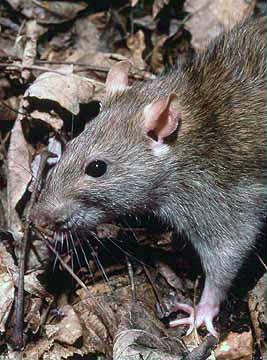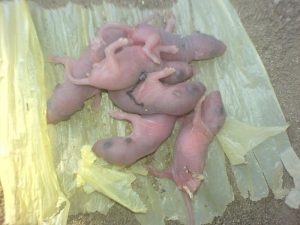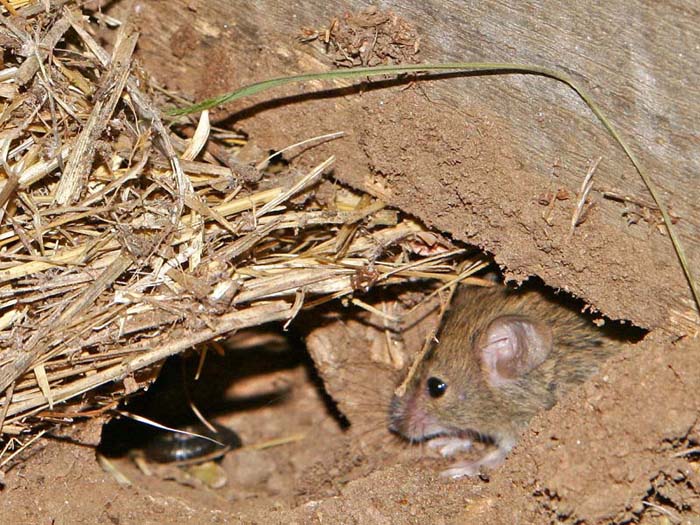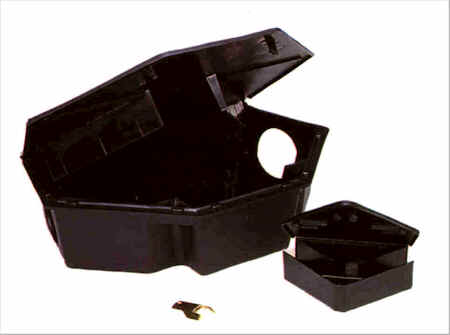Rodent control
Rodent control
Rodents, such as rats and mice, can be a major cost factor on the poultry farm because of the food that they eat and spoil with faeces and urine, the damage they do to the housing and equipment. Further, the diseases they may carry can result in flock health problems, staff health problems and/or food safety concerns regarding the products produced on the farm.

Brown rat
The cost of rodent infestations on poultry farms
Rodent infestations on poultry farms can result in economic loss in a number of ways:
- Feed loss – Rats will eat almost anything that could be classified as food including rotting materials and manure. However, they prefer good quality, fresh food – and this is plentiful around the poultry farm. Each rat can consume up to 30 g of food per day and will spoil much more. In addition, food stored in bags will be wasted if rodents are given the opportunity to establish themselves. At a consumption rate of 30 g per day, 1000 rats will eat approximately 11 tonnes in a year. In addition, rats and mice can often waste (through spillage) and spoil (through contamination with faeces and urine) more feed than they eat.
- Damage to buildings and equipment – Inside poultry houses rats, and to a lesser extent mice, cause damage to building structures, including foundations, water lines, electrical cables, etc. Damage to electric cables can lead to short circuits and are often the cause of fires and electrical failures.
- Damage to flocks – Rodents not only physically damage the building structures and equipment but they can also break and eat eggs and kill young chicks. Rodents are also major vectors (carriers) and reservoirs of poultry and zoonotic pathogens (pathogens that can be spread from animals to humans), including Pasteurella multocida, Salmonella typhimurium, S. enteritidis and influenza and infectious bursal disease viruses. After cleaning and disinfection of a poultry house, mouse populations can remain infected with bacteria and viruses that infect poultry for at least 10 months. Rodents also carry parasites such as lice, mites and fleas. In addition, rodents cause general nuisance for birds in the house due to their noise and movements. The birds may be frightened, which results in poor performance.
In relation to problems on poultry farms, mice can be considered to be small rats and pose the same problems in poultry sheds, particularly in relation to carrying disease.
The ecology of rodents on poultry farms
Rodents are important pests in the poultry house. In some poultry houses, building design and construction provide easy access to rodents. Once they are inside the poultry house they can easily burrow under dry matter, into deep litter or inside hollow walls and holes. They also move across by climbing through the openings for pipes, cables or cracks in the building. They use the framework of buildings as pathways when moving about the poultry house. Because they are active mainly at night they are seldom seen and hence it is usually necessary to look for other signs that they are present. They are not particular in their choice of living areas, requiring only a dry, secluded location in which to breed and rear their young.
Rats do most of their eating at night, usually taking a meal in the early part of the night and another towards morning. They are seldom active during the day, and it is this habit that allows a population to develop before they are noticed. Farm staff should check at night for rats, particularly when the lights in the house are out.
Some rats burrow to build their nests while others prefer suitable nesting places above the ground. When checking for their presence and nesting sites look for holes into the ground and through the floor as well as in suitable locations in bagged food, piles of empty bags and other equipment or material above ground. In time, as the population increases, signs of nesting and/or burrowing will be found. Rats breed very quickly, with one pair and their offspring being able to produce up to 800 young in 9 months. Therefore action should be taken immediately to remove the rats and mice before the populations can get a foothold.
Estimating the rodent population

The presence of rats and mice is not always obvious. However, one rule of thumb for the estimation of rat populations is as follows:
- Rat sign but no rats seen – 1 to 100.
- Occasional rat sightings at night – 100 to 500.
- Seen every night and occasionally by day – 500 to 1000.
- Many by night and day – up to 5000.
The frequency of catching rodents in traps may also be used to assess the level of infestation.

Feral mouse
Controlling a rodent problem
The cost of controlling rodents is small compared to the losses incurred through rodent infestation. It has generally been observed that preventative actions against rodent infestations are rarely as vigorous as the problem demands.
A continuous integrated programme to control rodents includes:
- Minimising points of access into buildings. Cracks and openings into sheds should be sealed with a material that cannot be gnawed by rodents, such as sheet metal, hardware cloth or cement.
- Preventing access to feed, water, and shelter.
- Elimination of nesting places. Make sure any material that would be attractive to rodents for nesting is placed in rodent proof storage areas. If the storage area cannot be rodent proofed, move the material at least every week to prevent rodents from establishing themselves in it. Place all bagged food and equipment on a platform about 60 centimetres off the ground and 60 centimetres from any wall. Always keep the building surrounds tidy and well mown. A heavy grass and weed growth around a stack of undisturbed timber or other material or equipment make an ideal nesting site. Ventilation control curtains that are not used and are left rolled for lengthy periods should be unrolled completely and re-rolled every two to three weeks to prevent rats and mice nesting in them. Failure to do this often results in the vermin nesting in the rolled curtains and, in time, destroying them by chewing large holes in them as they look for nesting material. Outdoor burrows may be closed by filling with soil and observed for reopening of entrances.
- Appropriate sanitation conditions, including tidying the shed inside by removing items that do not belong there and keeping strips near walls clear; regular cleaning by sweeping and removing all spilt feed, dead birds and broken eggs; checking incoming and outgoing materials for infestation; and, occasionally clearing the entire shed and cleaning it out thoroughly.
- Baiting and/or trapping programmes.
- Monitoring of rodent populations and control measures.
The effectiveness of rodent control programmes depend upon the people responsible for their implementation being aware of the problems involved, their motivation and their interest in achieving success. The tools required are: (a) regular monitoring, (b) well trained operators and (c) access to labour and materials when they are needed. It is fair to conclude that the problems with rodent control are mostly centred on people and not the rodents themselves.
Baiting and/or trapping programmes should start as soon as the shed has been built. It is best to prevent a high rodent population rather than to try to control it once it is there.

Rat bait station
Baiting
Baiting is a control method that uses rodenticides (chemicals which are poisonous to rodents), which are available in the form of fumigants, tracking powders, and acute and delayed toxicity baits. Rodenticides should be used in conjunction with traps for effective control. All rodenticides are poisonous at various levels for poultry, livestock, and humans. Caution in the use of rodenticides is required, and manufacturer’s label instructions should be strictly followed.
Locating bait stations
If starting a control program for the first time, start baiting before destroying likely nesting areas as part of a clean up. Destroying nesting areas before baiting and/or trapping will only result in most of the rodents moving elsewhere and not being caught by the programmes.
Baits are laid out at bait stations located on rodent pathways. The bait stations should be well planned and their use continued even after the birds have been removed. After the birds have been removed could well be the best time because the feed should have been removed as well and the rodents will be looking for food – therefore the baits will be more attractive to them.
The bait stations should be checked at least once per week and preferably twice per week if evidence shows the rodents are using them. Look for signs where rodents have been. It is likely that some stations will be used and some not used. Finding bait stations used in some locations only means that the rodents are concentrated in that area. It follows that it would be a good idea to add more stations in that vicinity.
If the baiting program doesn’t appear to be working and the population hasn’t changed it may be worthwhile to use a 10 days on, 10 days off baiting program. Rodents are very intelligent and may stop eating bait.
If possible, co-locate water with the bait for the rodents to drink. Quite often, they will drink and eat during the same period. If water is not readily available they are likely to leave the bait station to look for water.
Baits should be added to once a week or more often if necessary to keep them fresh. Take care not to spill the bait where the poultry can have access to it.
Constructing bait stations
A very effective rat bait station can be made using a 20 litre drum by cutting two holes big enough to permit the entry of the rats around the top and turning it upside down over the bait station. A small container of water is placed in with the bait. (The bottom of a soft drink or beer can cut off at a depth of about 20 mm makes an excellent water or food container). This not only makes a very good bait station, but when used in floor-housed poultry sheds also prevents the birds having access to the bait by accident. Another type of bait station can be made from 75 or 100 mm diameter PVC pipe cut into lengths about 500 to 750 mm long. These are placed against the outside of the wall of the shed at about 3 bay (12 m) intervals or are fixed to the bottom plate of the shed on the inside. (Note: they must be securely fixed to the bottom plate). Rat bait and water is placed in the middle of these lengths of pipe in a way that the birds cannot reach the bait. With a bit more effort a good bait station can be made by using 100 mm plastic pipe and joining it such a way that there are bends between the entry and the bait. This will give the rats a stronger feeling of being protected. Another option is an open large fish or meat tin with the top still attached by a small section of the edge. This tin is then fixed to a post at the top or other roof structure and a bait and water container placed in it.
Rodenticides
Fumigants can be used to control rodents in uninhabited areas such as out buildings, feed storage areas or burrows in the ground. Fumigants are available in solid (eg hydrogen cyanide as calcium cyanide, hydrogen phosphite as aluminium or magnesium phosphide), liquid (eg chloropicrin) and gaseous (eg methyl bromide) forms. Fumigants are also helpful to control insects in the same treatment.
Acute toxicity rodenticides are also called single-dose rodenticides and will kill rodents after one feeding if an adequate amount is consumed. Most single-dose compounds are highly toxic to all types of animals, including humans. They should be kept out of reach of children, pets, poultry and livestock. Only extreme situations call for the use of a single-dose rodenticide with high toxicity. The use of a zinc phosphide compound is helpful when there is a high population of rats. It should be used at a strength of 1 or 2 percent, by mixing one or two parts of the compound with 99 or 98 parts of a feed grain, such as broken rice. A small quantity of vegetable oil must be well mixed through the grain before mixing in the zinc phosphide. About 100 g of bait should be placed at each point along the inside walls of the poultry house.
Strychnine is also available in the market but it should be considered for short-term use only as rats and other rodents do not usually accept it. Other acute toxicity rodenticides include red squill (a powder made from the plant Urginea maritima), alpha-naphthylthiourea and sodium fluoracetate.
Delayed toxicity rodenticides, also known as multiple-dose compounds, have a cumulative effect and will kill rodents after several feedings. Bait has to be available continuously, and other feed sources must be removed. The rate of rodent kill depends on the type of rodenticide and the dose consumed. Some products kill within 1 hour, and others require 4 to 7 days after ingestion. Delayed toxicity rodenticides kill rodents by inhibiting the ability of the blood to coagulate (anti-coagulants), and death results from internal hemorrhages (bleeding). These products are much safer around all types of animals. Also the rodent usually does not identify its gradual illness with the bait. Baits are available in dry or wet form, in powder mixed with grain, in pellets, micro-encapsulated, in paste, in wax, or in water. For maximum effectiveness, bait should be available in both feed and water.
Warfarin (a product containing hydroxycoumarins) is a delayed toxicity rodenticide and is known as a first generation anticoagulant. It is a slow acting poison that reduces the amount of vitamin K in rats. Vitamin K is necessary for blood coagulation. This delayed action poison can be more effective than acute toxicity poisons.
If first generation anticoagulants become ineffective due to the development of resistance, then second-generation anticoagulants (difenacoum and brodifacoum) and non-anticoagulant delayed action rodenticide (cholecalciferol and bromethalin) are also available. However, the best way to control rodents is through an integrated programme that incorporates biological and managerial techniques to minimise any hazards to the environment as well as to other animals, birds, pets and man. That’s why it is important to keep the building rodent proof, clean, well ventilated and sanitised.
Always record details of the rodent baiting program. Keep records of every bait station location, bait station check and when bait is added to each station.
Trapping
Traps are another option and should be located on rodent pathways. When faced with a heavy infestation the traps should be checked and reset several times each night. Many types of traps are available and selection is based on spring strength and the sensitivity of the trigger. However, careful placement and baiting are also important factors. The only disadvantage of trapping is that continuous use of trapping leads to trap shyness (avoidance of traps). However, changing the placement and type of trap, along with the bait type, may be helpful to overcome this problem. In an effort to remove trap shyness baiting unset traps should be used until the bait has been removed at least once. Different fresh fruits, onion, peanut butter etc. and commercially available baits can be tried on unset traps to determine which ones work. Traps should be placed close to the wall, behind objects, or in dark corners where rodents may hide. The number of traps to be placed inside the shed depends on the size of the shed. Bait may need to be placed close to the trigger of the trap to increase the chances of success. Check the traps daily and collect any dead rats/mice and reset the traps.
Always record details of the location of traps and the number of rodents caught in the traps. Revise the location of traps to increase trap numbers where they are most effective.

